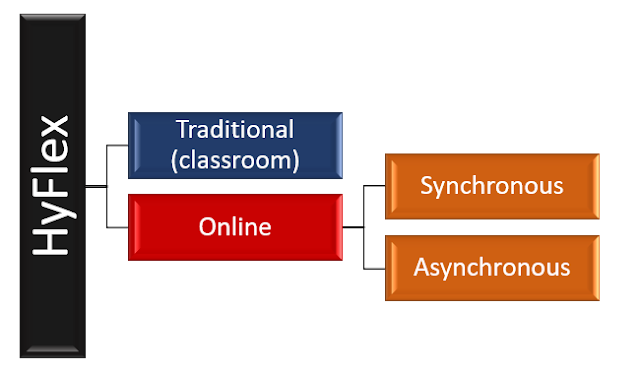College students face unprecedented challenges compared to the past and in order to serve their needs, colleges need to adopt customizable learning opportunities that are highly flexible. The success of online courses demonstrated that students needn’t be constrained to a geographical location, but can experience quality learning experiences at anytime, anywhere, and from a variety of devices. HyFlex teaching is aligned with this mission of offering more flexible learning environments. It aims to deliver students the maximal amount of choices possible within a formal learning program. Students are provided a choice between a variety of course delivery modes and can regularly change modes during the semester. MgGee and Reis (2012) define HyFlex where,
“course designs involve instructor and learners working
together in mixed delivery modes, typically face-to-face and technology
mediated, to accomplish learning outcomes that are pedagogically supported
through assignments, activities, and assessments as appropriate for a given
mode and which bridge course environments in a manner meaningful to the
learner.”
Essentially, a well-designed HyFlex course will provide effective alternative participation modes that all meet the same learning outcomes. This will provide meaningful learning opportunities for all students.
HyFlex instructors are not merely recording lectures for
students to asynchronously watch.
Instead, a full asynchronous version of the course offers an alternative
to the synchronous as well as face-to-face options (See Figure 1). It is
preferable to provide the content from the face-to-face delivery in an online
version as well. This will require little additional work if materials are
already available in digital format, however it is important that this format
is accessible (such as having closed captions).
 |
| Figure 1: The various modes of instruction in HyFlex |
- Principle 1 – Learner Choice: Provide meaningful alternative participation modes and enable students to choose between participation modes. This may be weekly, by class, or topically.
- Principle 2 – Equivalency: Provide equivalent learning activities in all participation modes. This is also good teaching practice in line with the theory of Universal Design for Learning.
- Principle 3 – Reusability: Utilize artifacts from learning activities in each participation mode as “learning objects” or resources for all students. Make use of your labor efficiently – this will make the process sustainable and affords students equitable access to learning resources.
- Principle 4 – Accessibility: Provide all students with technology skills and enable full access to instructional resources and activities in all participation modes. This may also require equitable access to minimal technology.
A key aspect of accessibility is the need to make all course
materials and activities accessible for all students.
Naturally, HyFlex courses require more time and work in
their development and delivery. In most cases, it may take close to twice as
much time. Nevertheless, the time spent is well worth it. This model both benefits the college and
students.
Colleges benefit from:
o
Insuring all courses are rigorously reviewed and
apply instructional design practices that are proven to increase student
success.
o
Crisis protection, as courses can immediately
continue online in the event of emergencies that would close the campus. Courses
would continue uninterrupted as the deliver would pivot to be online.
Students benefit from:
o
Well-designed courses that can accommodate
different learning styles.
o
Courses that accommodate the student need for
flexibility.
Doing HyFlex correctly to ensure all modes are equally provided for students is not a trivial task, but done correctly will afford students much needed flexibility that many students require. Besides offering benefits that increase student success, retention, and potentially enrollments, HyFlex can be a way of promoting equity in education.
References
Beatty, B. (2019) Four
Fundamental Principles for HyFlex – The Pillars
HyFlexWorld. Republished from 2010.
Retrieved: 3/26/2021
Beatty, B. (2012) HyFlex
Design Enables a Quick Flip.
HyFlexWorld. Retrieved: 3/30/2021.
Beatty, B. (2008). Sloan
Consortium Effective Practice Award: Using the “HyFlex” Course and Design
Process. Retrieved 02/28/2021
McGee, P. &. A. Reis (2012) “Blended Course Design: A Synthesis of Best Practices.” Journal of Asynchronous Learning Networks, 14(4).


No comments:
Post a Comment